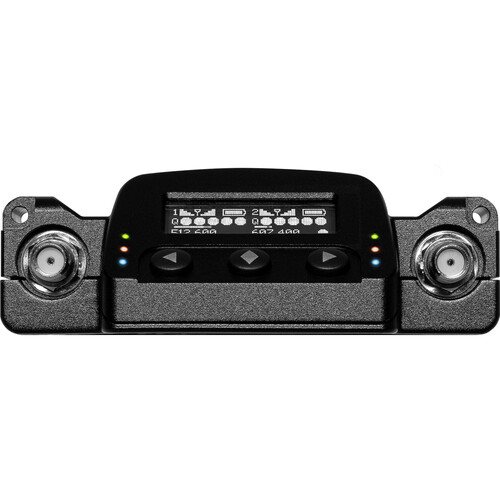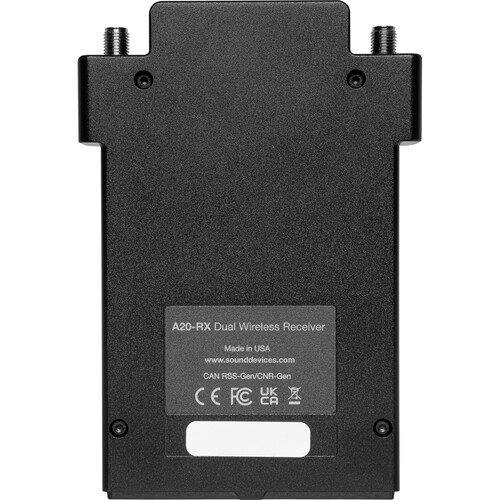- 1800 717 710 | Newsletter |
- FAQ |
- Contact
-
0 product
My Cart - Quick Order
- Home>
- Audio>
- Wireless Microphones>
- Receivers & accessories>
- Receivers >
- Sound Devices 2-Channel Digital Wireless Receiver with SpectraBand Technology
Sound Devices 2-Channel Digital Wireless Receiver with SpectraBand Technology
Product code : SOU.A20-RX
Experience ultimate flexibility as you find open spectrum away from the crowded UHF TV band. The A20-RX two channel true diversity receiver features industry-exclusive SpectraBand technology, which delivers a tuning range of 470 – 1525 MHz in a single unit. Superior low-loss, brick-wall SAW filters deliver excellent performance in noisy RF environments, while the AutoAssign feature makes frequency selection and setting quick and easy.
The system is completely digital, ensuring pristine quality audio and providing extremely long transmission distances with brick-wall SAW filters to eliminate out-of-band interference. The unit's AutoAssign function automatically scans a tuning band and selects clean, interference-free frequencies for you, saving you valuable time on set.
SpectraBand
SpectraBand technology delivers a tuning range of 470 – 1525 MHz in a single unit – an industry first. Experience ultimate flexibility as you find open spectrum away from the crowded UHF TV band.
AutoAssign
The A20-RX’s AutoAssign scans a tuning band and selects available frequencies for you – perfect for any fast-paced shoot. Meanwhile, brick-wall SAW filters eliminate out-of-band interference so you can get the best RF performance possible. Enjoy immunity from nearby IFB or camera hop transmitters without the need for external filters or extra cabling.
SpectraBand Technology: compatible with the A20-Mini from 470 MHz – 1525 MHz and all tuning ranges of the A10-TX
Advanced Digital True Diversity topology uses two complete RF receivers for each of the two channels, with four RF receivers in total
SuperSlot compatible with the SL-2 and 8-Series mixer-recorders
State-of-the-art 100% digital long-range modulation delivers the longest transmission distance of any digital system on the market.¹
GainForward Architecture compatible with the A20-Mini. Set the Mini’s gain levels via trim control (with an 8-Series) or at the A20-RX (for other mixers)
Full 10 Hz – 20 kHz audio bandwidth; 100% digital RF modulation and transmission
Excellent immunity from nearby IFB or camera hop transmitters without the need for external filters or extra cabling
Maximum connectivity: SuperSlot, XLR, and TA3 adapters, A-RXMON headphone amp, and A-15PIN two-channel AES Sony camera slot adapter
Analog line-level or AES digital audio output
Wireless TechnologyDigital UHF
DiversityTrue Digital Diversity
RF Frequency Band470 to 1525 MHz
Frequency Step Size25 kHz
RF Channel ScanningAuto-Scan
Timecode SupportNo
Control App SupportNo
Latency2 to 3.9 ms
ModulationProprietary
Receiver
Receiver TypeSlot-Mount (Bag Suitable)
Mounting OptionsSlot-Mount (with Included Hardware)
Antenna2 x 1/4 Wave Flexible Whip, SMA (Front-Mount)
Number of Audio Channels2
Audio I/O1 x DB-25 3-Pin Male Balanced Line Output
Slot-Mount I/O AdaptersIncluded:
DB-25 (Uni/SuperSlot)
Audio Output Level14 dBu (Max)
Phantom Power ProtectionNone
Frequency Response10 Hz to 20 kHz
Network I/ONone
Network ProtocolsNone
Word Clock I/ONone
USB/Lightning ConnectivityNone
Standalone Audio Interface CapableNo
Power RequirementsDC Input
DC Input Power6 to 18 VDC (via Mounting Slot)
Display & Indicators1 x Graphic LCD (Frequency, Multifunction, Peak, RF Level, Transmitter Battery Status)
Operating Temperature-10 to 55°C
Dimensions78.5 x 113.7 x 26.6 mm
Weight165 g (without Mounting Hardware)
SpectraBand Explained
Last updated August 25, 2022
SpectraBand is a brand-new technology which gives the A20-RX receiver and A20-Mini transmitter an unprecedented tuning range: 470 MHz – 1525 MHz. The advantages of SpectraBand to sound professionals are many:
More operating frequencies are available in a given location, alleviating the problem of no open spectrum to operate wireless mics.
Money is saved by purchasing only one piece of gear, which can be used anywhere, rather than special hardware variants of kit used for different locations.
Worldwide travel is easier, as the A20-RX and A20-Mini can use all legal frequency bands within their tuning range in any given country.
The SpectraBand hardware includes exceptional filtering that improves immunity from strong interfering signals (for example, a local DTV transmitter) or other transmitters close to the receiver (IFBs, 2-way radios, camera hops).
For reference, in the USA, SpectraBand provides access to approximately 285 MHz of available spectrum:
The entire UHF TV Band (470-608 MHz)
The 600 MHz Guard Band (614-616 MHz)
The 600 MHz Duplex Gap (653-663 MHz)
The 900 MHz ISM Band (902-928MHz)
The 950 MHz STL Band (941.5-960 MHz)
The 1.5 GHz AFTRCC Band (1435-1525 MHz), with an appropriate license.

In the UK, SpectraBand provides access to approximately 383 MHz of available spectrum:
The core UK UHF TV Band (470-702 MHz)
The 800 MHz Duplex Gap (823-832 MHz)
The 800 MHz SRD Band (863-865 MHz)
The DME bands (961-1015 MHz, 1045-1075 MHz, 1105-1154 MHz), with an appropriate license.
The IMT band (1518-1525 MHz)


This is not a comprehensive list of countries and their available bands. Visit this page to see frequencies available in other countries.
Several key technologies enable SpectraBand’s incredible range. These include brick-wall, SAW-based front-end filters, a wide-range local oscillator (LO), wide-range modulator/demodulator, and a high dynamic-range low-noise amplifier (LNA).
Filtering
In any RF system, proper filtering is necessary for excellent performance. Any time an amplifier is utilized in the signal chain, the amplifier must be preceded by a filter, or poor performance will result depending on the operating environment. This filtering prevents amplifier overload and the resulting distortion products which reduce operating range for the user. In an audio system, clipping of an amplifier is easy for a user to hear and remedy. This similar mechanism (RF amplifier overload) can be difficult to perceive in an RF system as everything can appear and sound ok, but the result (instead of distorted audio, as is the case in an audio system) is reduced operating range. Just as a audio bandpass filter helps an audio engineer deal with noise, a good RF filter helps an RF amplifier from misbehaving. The sharper the passband filter that can precede an RF amplifier without attenuating the wanted carrier, the better.

Shown in this picture is the A20-RX’s brick-wall SAW filter compared against two traditionally designed and well-regarded tracking filters currently on the market. The yellow trace is the A20-RX’s SAW filter centered at 573 MHz, the blue is competitor 1 and the green is competitor 2. As can be seen, the A20-RX’s filter exhibits a brick-wall type of response, being over 45 dB down at 603 MHz, while competitor 1 is down only about 2 dB, and competitor 2 is down only about 12 dB. This plot illustrates very clearly why the A20-RX’s filter can operate in closer proximity to strong interference with no change in performance: if an interferer (DTV or other transmitter) is at 603 MHz, it is greatly attenuated by the SAW filter and does not change performance of the A20-RX. The A20-RX has a network of over 40 fixed SAW filters on the A and B antenna inputs. These filter ranges have been carefully selected for broad compatibility with Program Making and Special Events (PMSE) and DTV wireless spectrum worldwide. Brick-wall SAW filters allow for unsurpassed immunity to out-of-band interference.
Local Oscillator (LO) and modulator/demodulator
In a wireless mic transmitter, digital audio signals must be up-converted to radio frequency (RF) signals with a modulator chip for transmission through the air. This modulator is driven by a local oscillator (LO). Both the modulator and LO need to be designed with extreme care in order to operate reliably from 470 MHz – 1525 MHz. Sound Devices uses the latest in low-current, low phase-noise LO and field-programmable gate array (FPGA) design to satisfy these requirements, which were simply not available just a few years ago.
Likewise, a wireless microphone receiver needs to down convert the received RF signal back into digital audio data. This down conversion is done with the very latest high-quality flexible demodulator and LO. The A20-RX uses a proven dual downconverter superheterodyne topology with extensive SAW filtering to ensure the best possible selectivity (see picture below). This takes more parts than other topologies, but ultimately results in excellent nearby signal rejection, yielding improved operating distance.

Low Noise and High IP3 LNA
Much like a mic preamp in an audio system, a low-noise RF amplifier (LNA) is the first active device in an RF signal path (see item 2 in the picture above) and can define the quality of the entire system following it. For high performance, a quiet LNA is necessary. The Noise Figure (NF) specification quantifies how quiet the LNA is. A low NF will allow for very long-range operation, much like a good, quiet mic preamp allows for recording of very low acoustic levels. However, a quiet LNA is only half of the equation. The overload of an LNA is specified by its 3rd-order-intercept point (IP3). Again, back to the mic preamp analogy, the IP3 of an LNA is like the headroom of a mic preamp. If the IP3 of the LNA is too low, strong interfering signals, whether from a nearby 2-way radio or other strong transmitter near the receiver can overload the LNA, generating distortion, and greatly reducing the operating distance of the wireless microphone system. The Sound Devices A20-RX uses the very latest in E-pHEMT transistors, utilizing an LNA which has a NF of just 0.3 dB while simultaneously offering +39 dBm of output IP3: super quiet, with loads of headroom.
Conclusion
Whether you work locally or travel worldwide, the A20 System gives you a wider choice of operating frequencies. As the wireless spectrum becomes increasingly crowded, having extra flexibility in tuning range is imperative. The A20-RX is the only digital receiver on the market that can tune not only in common UHF TV bands around 470 – 608 MHz, but also far above that.
If you wish to purchase in store, to avoid disappointment, please confirm the availability of the product at your local John Barry prior to visiting.
Alternatively, orders placed online by 2pm AEST are typically dispatched same day, if ordered online.
If your product is on backorder, please contact us for an ETA.
Shipping is done via Startrack Express or Australia Post eParcel service and tracking advice will be provided once shipped.
For more information, please visit our Shipping Policy.
Should you have any questions regarding our equipment warranty conditions, please contact us
John Barry reserves the right under Australian Consumer Law to refuse a request for an exchange or refund on all final sale items, if you have misused/mishandled the product, or if you have simply changed your mind. Please visit our Refunds & Returns policy page for further information.



